Overview
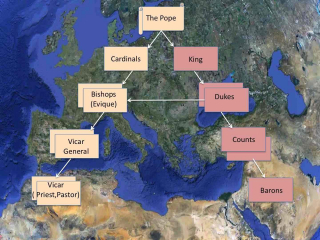 The Pope of the time developed the concept of right to rule. He maintained that Roman Emperor Constantine the Great had given the Popes of Rome the right to the temporal rule of the Western Empire. This was ultimately supported by documentation known as the “Donation of Constantine” (which much later was proved to be one of the greatest forgeries and therefore frauds, of all time). Nevertheless the Pope used this concept to intervene and appoint the untrustworthy devious, murderous, teenage leader of the Frankish tribe to be his Magister Militarum. A cursory examination of the titles chosen for the new Church of Rome hierachy shows that it was the Church itself which was intended to provide the civil governance.
The leader of the Franks was called Clovis and the Dynasty he founded the Merovingians.
There are many legends about why the Pope, chose Clovis, but it was really because he permitted the Church of Rome to adopt, at least in the short term, the role it had assigned to itself - to become the spiritual and temporal ruler of the Western Empire. Clovis became the classic Client King. His job was simply to use his ruthless political and military skills to eliminate the opposition, which he did, with brutal efficiency.In the 14th Century it is extremely doubtful whether Europeans identified themselves with any particular nation. They might see themselves as Gascon, Breton or Angevin, perhaps even as Béarnaise, Armagnac, Savoyard or Provencale but not as French Or Occitan. The formation of the state of Aragon, the Scottish declaration of independence and the Frankish invasion of the lands of Occitan all signaled the end of feudalism. In Occitan the extermination of the local counts and their replacement with northerners, a complete contradiction of feudalism, raised great resentment. It took nearly the whole of the 14thcentury for the concept of nationhood to be understood and applied and not everyone embraced the concept: particularly not the inhabitants of Occitan.
The Pope of the time developed the concept of right to rule. He maintained that Roman Emperor Constantine the Great had given the Popes of Rome the right to the temporal rule of the Western Empire. This was ultimately supported by documentation known as the “Donation of Constantine” (which much later was proved to be one of the greatest forgeries and therefore frauds, of all time). Nevertheless the Pope used this concept to intervene and appoint the untrustworthy devious, murderous, teenage leader of the Frankish tribe to be his Magister Militarum. A cursory examination of the titles chosen for the new Church of Rome hierachy shows that it was the Church itself which was intended to provide the civil governance.
The leader of the Franks was called Clovis and the Dynasty he founded the Merovingians.
There are many legends about why the Pope, chose Clovis, but it was really because he permitted the Church of Rome to adopt, at least in the short term, the role it had assigned to itself - to become the spiritual and temporal ruler of the Western Empire. Clovis became the classic Client King. His job was simply to use his ruthless political and military skills to eliminate the opposition, which he did, with brutal efficiency.In the 14th Century it is extremely doubtful whether Europeans identified themselves with any particular nation. They might see themselves as Gascon, Breton or Angevin, perhaps even as Béarnaise, Armagnac, Savoyard or Provencale but not as French Or Occitan. The formation of the state of Aragon, the Scottish declaration of independence and the Frankish invasion of the lands of Occitan all signaled the end of feudalism. In Occitan the extermination of the local counts and their replacement with northerners, a complete contradiction of feudalism, raised great resentment. It took nearly the whole of the 14thcentury for the concept of nationhood to be understood and applied and not everyone embraced the concept: particularly not the inhabitants of Occitan.
Negotiating rights
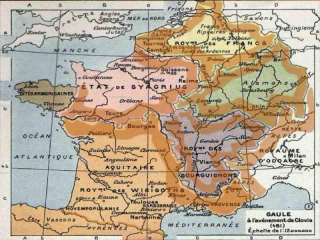 The feudal system, as introduced by Clovis, relied on the oath of allegiance. Of course allegiances can be changed. Even before Clovis conquest and certainly in the negotiations during the conquest itself the Comtes whose property lay close to borders were taught an important lesson.They learned that though they were exposed to risk of attack across the border they also had the ability to change their allegiance and therefore were able to negotiate either side of the border for advantageous terms.
The feudal system, as introduced by Clovis, relied on the oath of allegiance. Of course allegiances can be changed. Even before Clovis conquest and certainly in the negotiations during the conquest itself the Comtes whose property lay close to borders were taught an important lesson.They learned that though they were exposed to risk of attack across the border they also had the ability to change their allegiance and therefore were able to negotiate either side of the border for advantageous terms.
The Marcher Territories
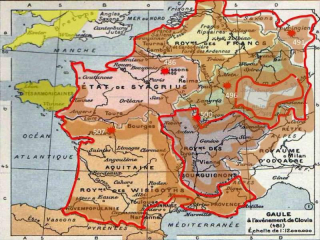 Clovis’ conquerst did not remove the border areas. By his failure to fully conquor either the Alamans or the Burgundians, plus the interfaces created with Gascon, Breton and Visigothic lands Clovis had created an Empire which had literally thousands of miles of border territories. These became known as marcher territories.
Clovis’ conquerst did not remove the border areas. By his failure to fully conquor either the Alamans or the Burgundians, plus the interfaces created with Gascon, Breton and Visigothic lands Clovis had created an Empire which had literally thousands of miles of border territories. These became known as marcher territories.
Frankish Inheritance
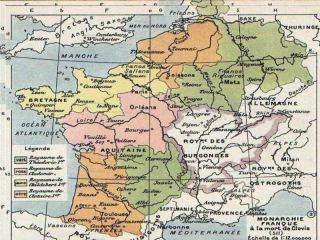 The Franks had a tradition of dividing all property equally amongst children. Also traditionally their leader had been acclaimed by popular vote. Clovis, probably influenced by the Church of Rome; who would have disliked the uncertainty of a popular vote, appointed his sons as rulers but subdivided the Kingdom between them. This was not peaceful co-existence. They warred with each other.
The Franks had a tradition of dividing all property equally amongst children. Also traditionally their leader had been acclaimed by popular vote. Clovis, probably influenced by the Church of Rome; who would have disliked the uncertainty of a popular vote, appointed his sons as rulers but subdivided the Kingdom between them. This was not peaceful co-existence. They warred with each other.
Shifting Boundaries
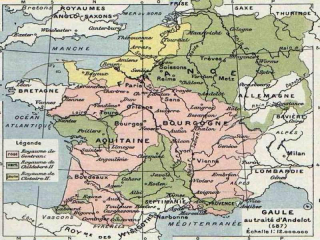 Another set of marcher territories was produced and another set of landowners were introduced to the concept of shifting allegiances and negotiating beneficial terms. And so it progressed, each generation produced a new subdivision of the realm and a greater and greater proportion of the Comtes and Barons learned the personal benefit of shifting alliances.
Another set of marcher territories was produced and another set of landowners were introduced to the concept of shifting allegiances and negotiating beneficial terms. And so it progressed, each generation produced a new subdivision of the realm and a greater and greater proportion of the Comtes and Barons learned the personal benefit of shifting alliances.
